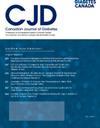Rising Prevalence of Gestational Diabetes Mellitus in Ontario: A Population-based Study
IF 2.3
4区 医学
Q3 ENDOCRINOLOGY & METABOLISM
引用次数: 0
Abstract
Objectives
Gestational diabetes mellitus (GDM) is a common pregnancy complication. Studies have shown that the prevalence of GDM is rising worldwide. In this study, we aimed to describe the prevalence of GDM in Ontario, Canada, between 2015 and 2021.
Methods
Population-based linked health-care administrative databases were used to identify women with GDM via a validated algorithm. Age-standardized GDM prevalence was described for each year between 2015 and 2021. Crude GDM prevalence trends were stratified according to age and income, and trend over time was evaluated using negative binomial regression.
Results
Crude GDM prevalence was 9.5% within this period, with age-standardized prevalence increasing by 35% over the duration of the study (p<0.0001). Prevalence declined in the first year of the COVID-19 pandemic, but it rose again the next year. Prevalence was directly associated with age (p<0.0001) and inversely associated with income (p=0.04), but these disparities did not change over time.
Conclusions
GDM prevalence is rising, but the transient decline in the first year of the pandemic may reflect forgone GDM screening. Disparities in prevalence by age and income are not worsening. GDM is creating a growing burden for the health-care system, particularly for lower income individuals.
安大略省妊娠糖尿病发病率上升:基于人口的研究。
目的:妊娠糖尿病(GDM)是一种常见的妊娠并发症。以往的研究表明,全球各国的 GDM 患病率都在上升。我们旨在描述 2015 年至 2021 年加拿大安大略省的 GDM 患病率:方法:使用基于人口的关联医疗保健管理数据库,通过验证算法识别患有 GDM 的妇女。对 2015 年至 2021 年期间每年的年龄标准化 GDM 患病率进行了描述。根据年龄和收入对 GDM 的粗患病率趋势进行分层,并使用负二项回归法评估随时间变化的趋势:结果:在此期间,GDM 的粗患病率为 9.5%,年龄标准化患病率在研究期间增加了 35%(p 结论:GDM 的患病率正在上升:GDM 患病率正在上升,但在大流行第一年出现的短暂下降可能反映出放弃了 GDM 筛查。不同年龄和不同收入人群的患病率差异并未恶化。GDM 给医疗系统造成的负担越来越重,尤其是对低收入人群而言。
本文章由计算机程序翻译,如有差异,请以英文原文为准。
求助全文
约1分钟内获得全文
求助全文
来源期刊

Canadian Journal of Diabetes
ENDOCRINOLOGY & METABOLISM-
CiteScore
4.80
自引率
4.00%
发文量
130
审稿时长
54 days
期刊介绍:
The Canadian Journal of Diabetes is Canada''s only diabetes-oriented, peer-reviewed, interdisciplinary journal for diabetes health-care professionals.
Published bimonthly, the Canadian Journal of Diabetes contains original articles; reviews; case reports; shorter articles such as Perspectives in Practice, Practical Diabetes and Innovations in Diabetes Care; Diabetes Dilemmas and Letters to the Editor.
 求助内容:
求助内容: 应助结果提醒方式:
应助结果提醒方式:


